Comparative Analysis of Business Environment in Three Sectors
VerifiedAdded on 2020/11/12
|12
|3219
|171
Report
AI Summary
This report provides an in-depth analysis of the business environment, focusing on how private, public, and voluntary sectors meet the objectives of their stakeholders. The report utilizes the Gibbs reflective cycle to analyze the business environment of IKEA (private), BP PLC (public), and the American Red Cross (voluntary). It examines the legal forms, purposes, and stakeholder objectives of each organization. The analysis includes Porter's five forces to assess the bargaining power of buyers and suppliers, the threat of substitutes and new entrants, and competitive rivalry within each sector. The report concludes with an evaluation of the model and suggests potential actions for future analysis and research, including an exploration of alternative models to Porter's five forces.
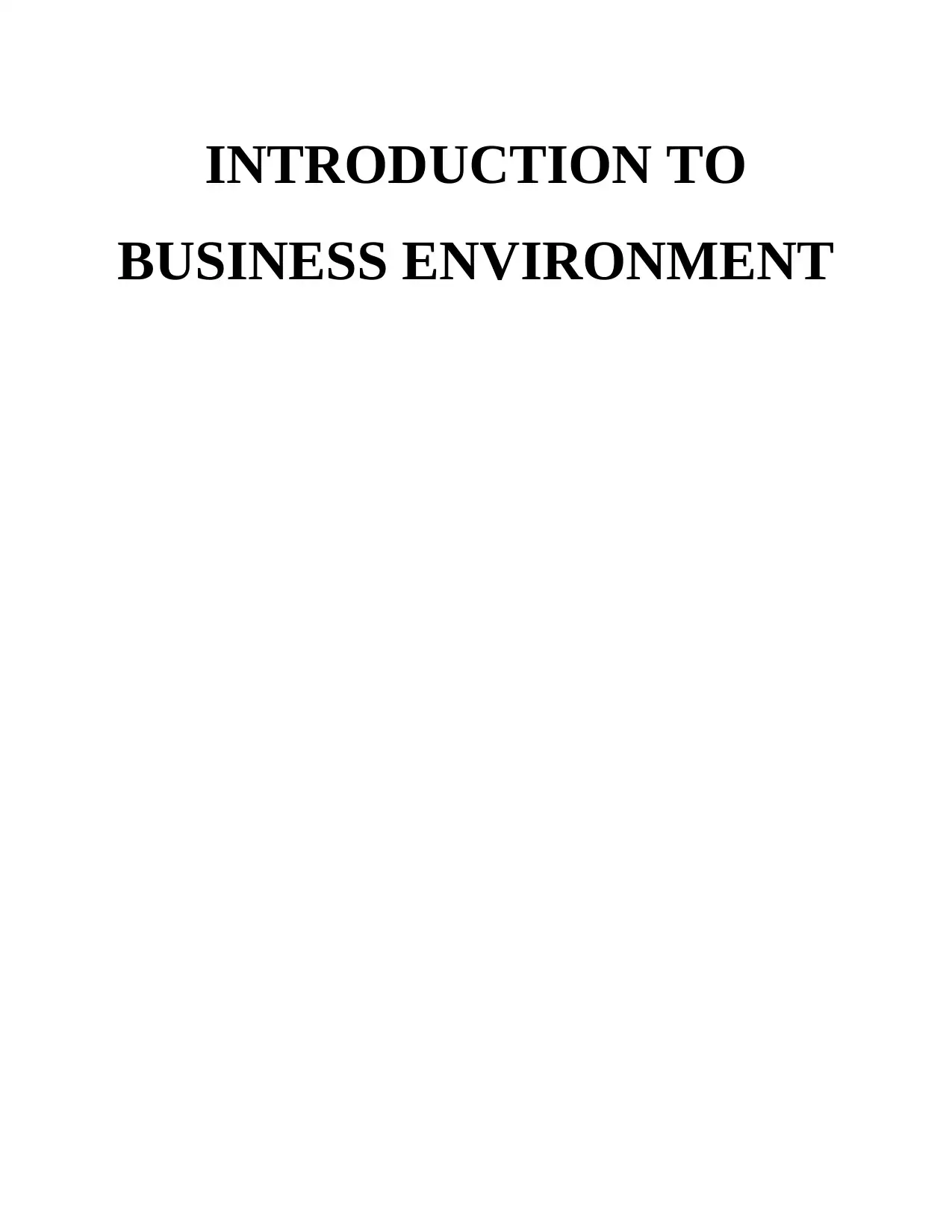
INTRODUCTION TO
BUSINESS ENVIRONMENT
BUSINESS ENVIRONMENT
Paraphrase This Document
Need a fresh take? Get an instant paraphrase of this document with our AI Paraphraser
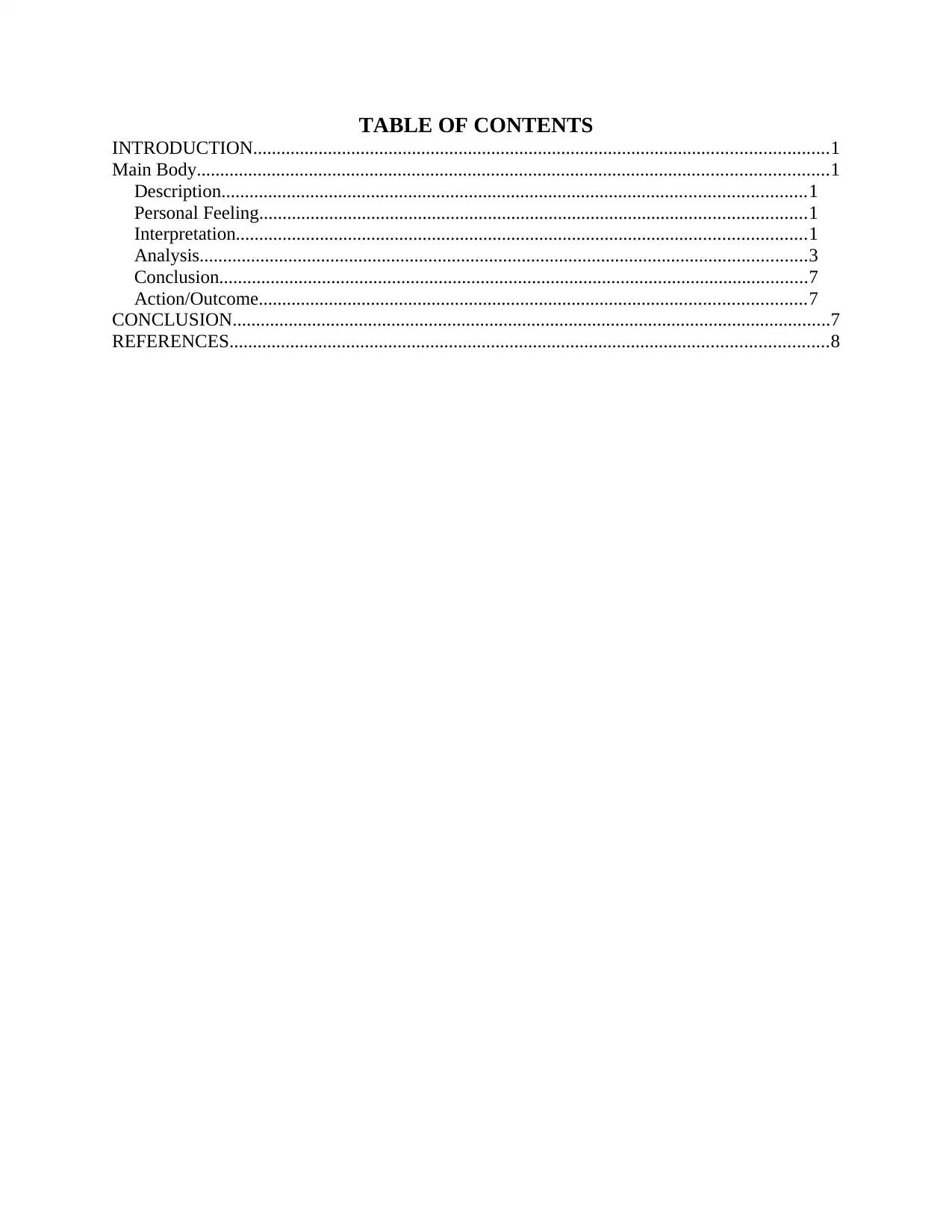
TABLE OF CONTENTS
INTRODUCTION...........................................................................................................................1
Main Body.......................................................................................................................................1
Description.............................................................................................................................1
Personal Feeling.....................................................................................................................1
Interpretation..........................................................................................................................1
Analysis..................................................................................................................................3
Conclusion..............................................................................................................................7
Action/Outcome.....................................................................................................................7
CONCLUSION................................................................................................................................7
REFERENCES................................................................................................................................8
INTRODUCTION...........................................................................................................................1
Main Body.......................................................................................................................................1
Description.............................................................................................................................1
Personal Feeling.....................................................................................................................1
Interpretation..........................................................................................................................1
Analysis..................................................................................................................................3
Conclusion..............................................................................................................................7
Action/Outcome.....................................................................................................................7
CONCLUSION................................................................................................................................7
REFERENCES................................................................................................................................8
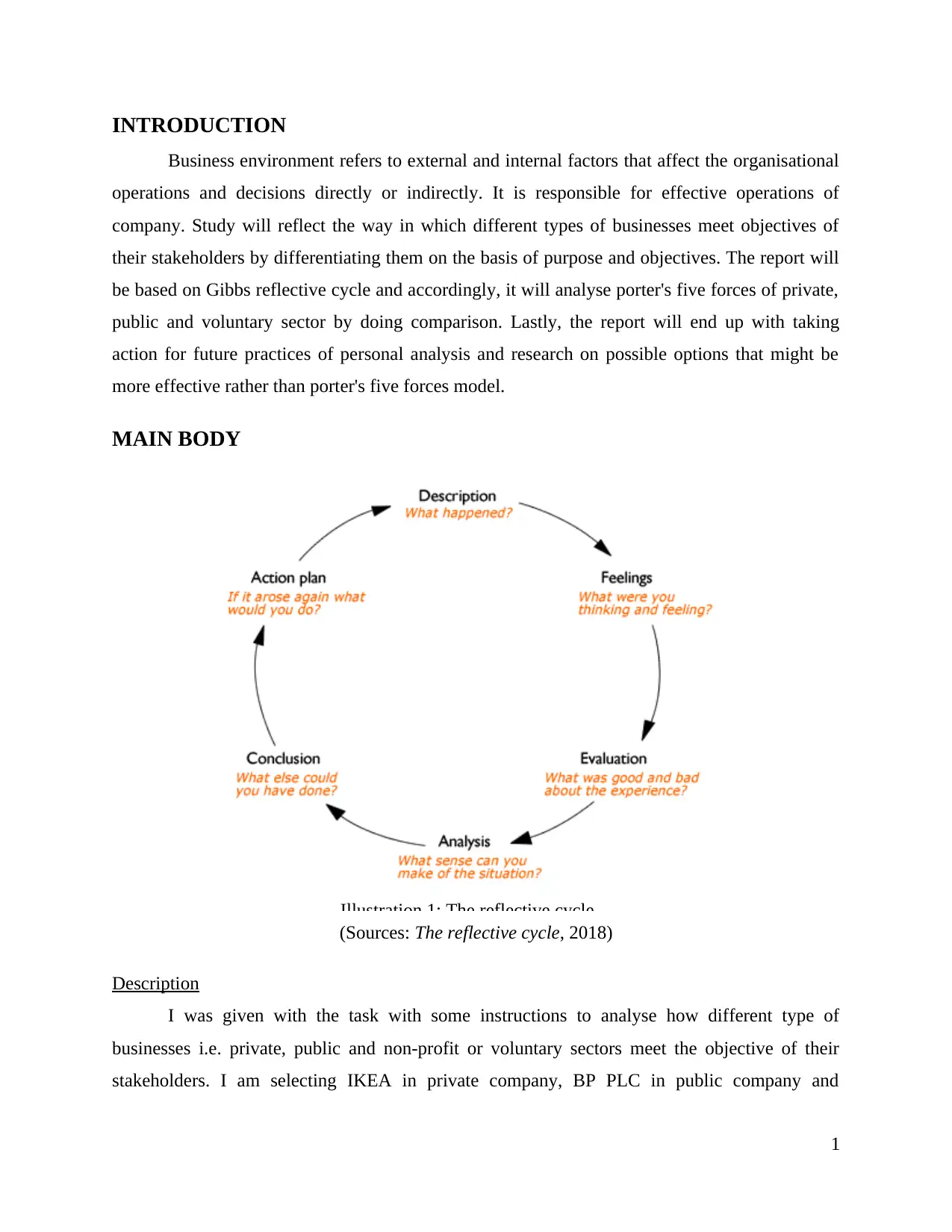
INTRODUCTION
Business environment refers to external and internal factors that affect the organisational
operations and decisions directly or indirectly. It is responsible for effective operations of
company. Study will reflect the way in which different types of businesses meet objectives of
their stakeholders by differentiating them on the basis of purpose and objectives. The report will
be based on Gibbs reflective cycle and accordingly, it will analyse porter's five forces of private,
public and voluntary sector by doing comparison. Lastly, the report will end up with taking
action for future practices of personal analysis and research on possible options that might be
more effective rather than porter's five forces model.
MAIN BODY
(Sources: The reflective cycle, 2018)
Description
I was given with the task with some instructions to analyse how different type of
businesses i.e. private, public and non-profit or voluntary sectors meet the objective of their
stakeholders. I am selecting IKEA in private company, BP PLC in public company and
1
Illustration 1: The reflective cycle
Business environment refers to external and internal factors that affect the organisational
operations and decisions directly or indirectly. It is responsible for effective operations of
company. Study will reflect the way in which different types of businesses meet objectives of
their stakeholders by differentiating them on the basis of purpose and objectives. The report will
be based on Gibbs reflective cycle and accordingly, it will analyse porter's five forces of private,
public and voluntary sector by doing comparison. Lastly, the report will end up with taking
action for future practices of personal analysis and research on possible options that might be
more effective rather than porter's five forces model.
MAIN BODY
(Sources: The reflective cycle, 2018)
Description
I was given with the task with some instructions to analyse how different type of
businesses i.e. private, public and non-profit or voluntary sectors meet the objective of their
stakeholders. I am selecting IKEA in private company, BP PLC in public company and
1
Illustration 1: The reflective cycle
⊘ This is a preview!⊘
Do you want full access?
Subscribe today to unlock all pages.

Trusted by 1+ million students worldwide
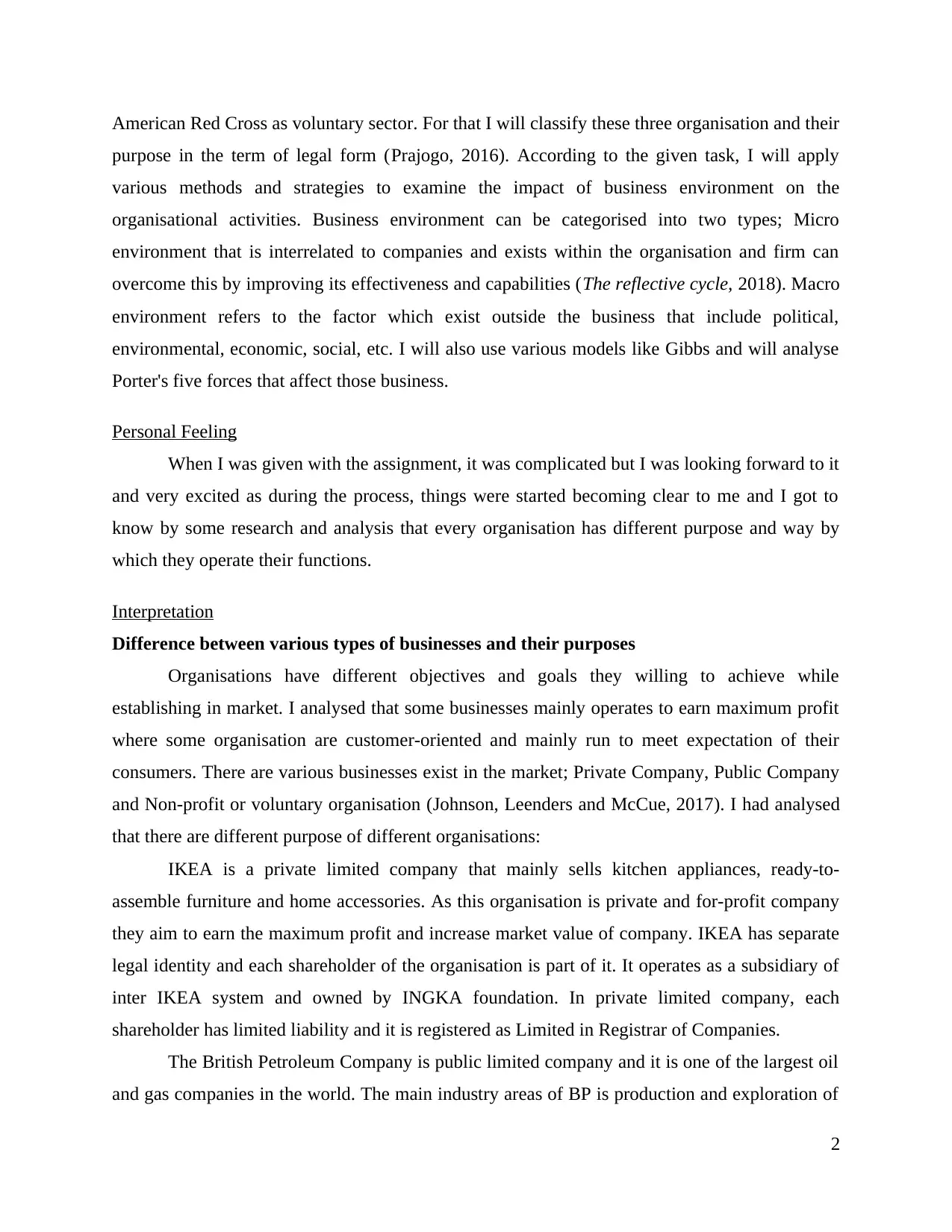
American Red Cross as voluntary sector. For that I will classify these three organisation and their
purpose in the term of legal form (Prajogo, 2016). According to the given task, I will apply
various methods and strategies to examine the impact of business environment on the
organisational activities. Business environment can be categorised into two types; Micro
environment that is interrelated to companies and exists within the organisation and firm can
overcome this by improving its effectiveness and capabilities (The reflective cycle, 2018). Macro
environment refers to the factor which exist outside the business that include political,
environmental, economic, social, etc. I will also use various models like Gibbs and will analyse
Porter's five forces that affect those business.
Personal Feeling
When I was given with the assignment, it was complicated but I was looking forward to it
and very excited as during the process, things were started becoming clear to me and I got to
know by some research and analysis that every organisation has different purpose and way by
which they operate their functions.
Interpretation
Difference between various types of businesses and their purposes
Organisations have different objectives and goals they willing to achieve while
establishing in market. I analysed that some businesses mainly operates to earn maximum profit
where some organisation are customer-oriented and mainly run to meet expectation of their
consumers. There are various businesses exist in the market; Private Company, Public Company
and Non-profit or voluntary organisation (Johnson, Leenders and McCue, 2017). I had analysed
that there are different purpose of different organisations:
IKEA is a private limited company that mainly sells kitchen appliances, ready-to-
assemble furniture and home accessories. As this organisation is private and for-profit company
they aim to earn the maximum profit and increase market value of company. IKEA has separate
legal identity and each shareholder of the organisation is part of it. It operates as a subsidiary of
inter IKEA system and owned by INGKA foundation. In private limited company, each
shareholder has limited liability and it is registered as Limited in Registrar of Companies.
The British Petroleum Company is public limited company and it is one of the largest oil
and gas companies in the world. The main industry areas of BP is production and exploration of
2
purpose in the term of legal form (Prajogo, 2016). According to the given task, I will apply
various methods and strategies to examine the impact of business environment on the
organisational activities. Business environment can be categorised into two types; Micro
environment that is interrelated to companies and exists within the organisation and firm can
overcome this by improving its effectiveness and capabilities (The reflective cycle, 2018). Macro
environment refers to the factor which exist outside the business that include political,
environmental, economic, social, etc. I will also use various models like Gibbs and will analyse
Porter's five forces that affect those business.
Personal Feeling
When I was given with the assignment, it was complicated but I was looking forward to it
and very excited as during the process, things were started becoming clear to me and I got to
know by some research and analysis that every organisation has different purpose and way by
which they operate their functions.
Interpretation
Difference between various types of businesses and their purposes
Organisations have different objectives and goals they willing to achieve while
establishing in market. I analysed that some businesses mainly operates to earn maximum profit
where some organisation are customer-oriented and mainly run to meet expectation of their
consumers. There are various businesses exist in the market; Private Company, Public Company
and Non-profit or voluntary organisation (Johnson, Leenders and McCue, 2017). I had analysed
that there are different purpose of different organisations:
IKEA is a private limited company that mainly sells kitchen appliances, ready-to-
assemble furniture and home accessories. As this organisation is private and for-profit company
they aim to earn the maximum profit and increase market value of company. IKEA has separate
legal identity and each shareholder of the organisation is part of it. It operates as a subsidiary of
inter IKEA system and owned by INGKA foundation. In private limited company, each
shareholder has limited liability and it is registered as Limited in Registrar of Companies.
The British Petroleum Company is public limited company and it is one of the largest oil
and gas companies in the world. The main industry areas of BP is production and exploration of
2
Paraphrase This Document
Need a fresh take? Get an instant paraphrase of this document with our AI Paraphraser
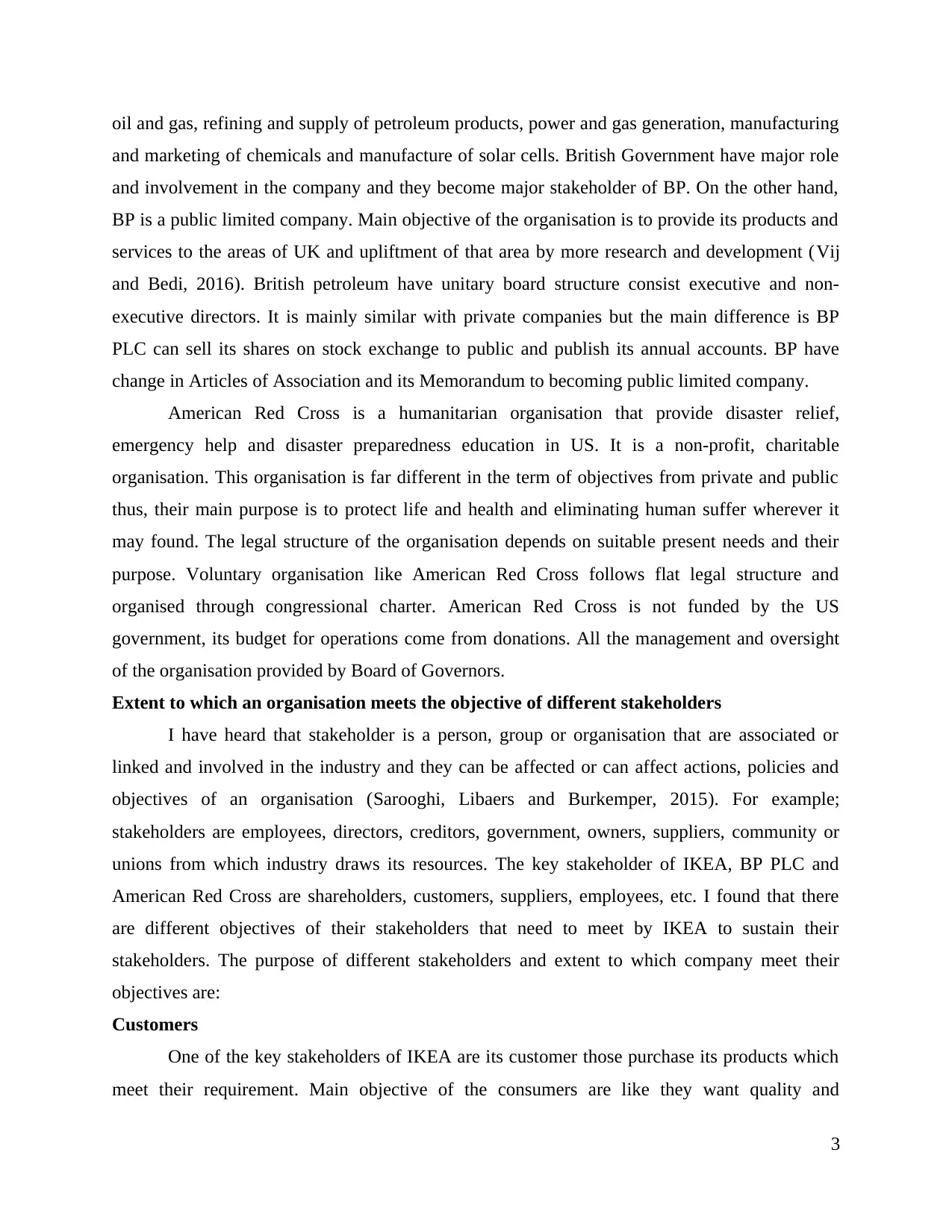
oil and gas, refining and supply of petroleum products, power and gas generation, manufacturing
and marketing of chemicals and manufacture of solar cells. British Government have major role
and involvement in the company and they become major stakeholder of BP. On the other hand,
BP is a public limited company. Main objective of the organisation is to provide its products and
services to the areas of UK and upliftment of that area by more research and development (Vij
and Bedi, 2016). British petroleum have unitary board structure consist executive and non-
executive directors. It is mainly similar with private companies but the main difference is BP
PLC can sell its shares on stock exchange to public and publish its annual accounts. BP have
change in Articles of Association and its Memorandum to becoming public limited company.
American Red Cross is a humanitarian organisation that provide disaster relief,
emergency help and disaster preparedness education in US. It is a non-profit, charitable
organisation. This organisation is far different in the term of objectives from private and public
thus, their main purpose is to protect life and health and eliminating human suffer wherever it
may found. The legal structure of the organisation depends on suitable present needs and their
purpose. Voluntary organisation like American Red Cross follows flat legal structure and
organised through congressional charter. American Red Cross is not funded by the US
government, its budget for operations come from donations. All the management and oversight
of the organisation provided by Board of Governors.
Extent to which an organisation meets the objective of different stakeholders
I have heard that stakeholder is a person, group or organisation that are associated or
linked and involved in the industry and they can be affected or can affect actions, policies and
objectives of an organisation (Sarooghi, Libaers and Burkemper, 2015). For example;
stakeholders are employees, directors, creditors, government, owners, suppliers, community or
unions from which industry draws its resources. The key stakeholder of IKEA, BP PLC and
American Red Cross are shareholders, customers, suppliers, employees, etc. I found that there
are different objectives of their stakeholders that need to meet by IKEA to sustain their
stakeholders. The purpose of different stakeholders and extent to which company meet their
objectives are:
Customers
One of the key stakeholders of IKEA are its customer those purchase its products which
meet their requirement. Main objective of the consumers are like they want quality and
3
and marketing of chemicals and manufacture of solar cells. British Government have major role
and involvement in the company and they become major stakeholder of BP. On the other hand,
BP is a public limited company. Main objective of the organisation is to provide its products and
services to the areas of UK and upliftment of that area by more research and development (Vij
and Bedi, 2016). British petroleum have unitary board structure consist executive and non-
executive directors. It is mainly similar with private companies but the main difference is BP
PLC can sell its shares on stock exchange to public and publish its annual accounts. BP have
change in Articles of Association and its Memorandum to becoming public limited company.
American Red Cross is a humanitarian organisation that provide disaster relief,
emergency help and disaster preparedness education in US. It is a non-profit, charitable
organisation. This organisation is far different in the term of objectives from private and public
thus, their main purpose is to protect life and health and eliminating human suffer wherever it
may found. The legal structure of the organisation depends on suitable present needs and their
purpose. Voluntary organisation like American Red Cross follows flat legal structure and
organised through congressional charter. American Red Cross is not funded by the US
government, its budget for operations come from donations. All the management and oversight
of the organisation provided by Board of Governors.
Extent to which an organisation meets the objective of different stakeholders
I have heard that stakeholder is a person, group or organisation that are associated or
linked and involved in the industry and they can be affected or can affect actions, policies and
objectives of an organisation (Sarooghi, Libaers and Burkemper, 2015). For example;
stakeholders are employees, directors, creditors, government, owners, suppliers, community or
unions from which industry draws its resources. The key stakeholder of IKEA, BP PLC and
American Red Cross are shareholders, customers, suppliers, employees, etc. I found that there
are different objectives of their stakeholders that need to meet by IKEA to sustain their
stakeholders. The purpose of different stakeholders and extent to which company meet their
objectives are:
Customers
One of the key stakeholders of IKEA are its customer those purchase its products which
meet their requirement. Main objective of the consumers are like they want quality and
3
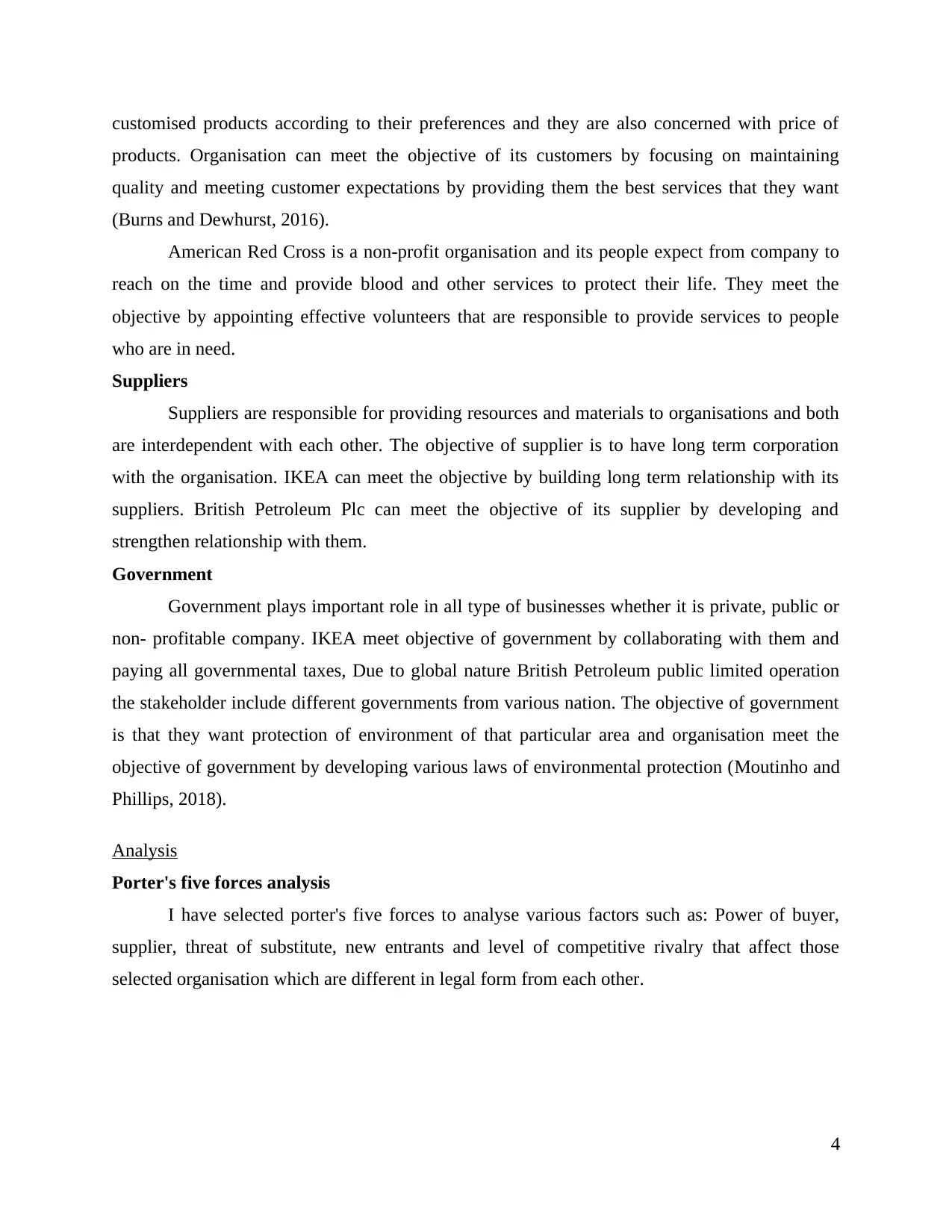
customised products according to their preferences and they are also concerned with price of
products. Organisation can meet the objective of its customers by focusing on maintaining
quality and meeting customer expectations by providing them the best services that they want
(Burns and Dewhurst, 2016).
American Red Cross is a non-profit organisation and its people expect from company to
reach on the time and provide blood and other services to protect their life. They meet the
objective by appointing effective volunteers that are responsible to provide services to people
who are in need.
Suppliers
Suppliers are responsible for providing resources and materials to organisations and both
are interdependent with each other. The objective of supplier is to have long term corporation
with the organisation. IKEA can meet the objective by building long term relationship with its
suppliers. British Petroleum Plc can meet the objective of its supplier by developing and
strengthen relationship with them.
Government
Government plays important role in all type of businesses whether it is private, public or
non- profitable company. IKEA meet objective of government by collaborating with them and
paying all governmental taxes, Due to global nature British Petroleum public limited operation
the stakeholder include different governments from various nation. The objective of government
is that they want protection of environment of that particular area and organisation meet the
objective of government by developing various laws of environmental protection (Moutinho and
Phillips, 2018).
Analysis
Porter's five forces analysis
I have selected porter's five forces to analyse various factors such as: Power of buyer,
supplier, threat of substitute, new entrants and level of competitive rivalry that affect those
selected organisation which are different in legal form from each other.
4
products. Organisation can meet the objective of its customers by focusing on maintaining
quality and meeting customer expectations by providing them the best services that they want
(Burns and Dewhurst, 2016).
American Red Cross is a non-profit organisation and its people expect from company to
reach on the time and provide blood and other services to protect their life. They meet the
objective by appointing effective volunteers that are responsible to provide services to people
who are in need.
Suppliers
Suppliers are responsible for providing resources and materials to organisations and both
are interdependent with each other. The objective of supplier is to have long term corporation
with the organisation. IKEA can meet the objective by building long term relationship with its
suppliers. British Petroleum Plc can meet the objective of its supplier by developing and
strengthen relationship with them.
Government
Government plays important role in all type of businesses whether it is private, public or
non- profitable company. IKEA meet objective of government by collaborating with them and
paying all governmental taxes, Due to global nature British Petroleum public limited operation
the stakeholder include different governments from various nation. The objective of government
is that they want protection of environment of that particular area and organisation meet the
objective of government by developing various laws of environmental protection (Moutinho and
Phillips, 2018).
Analysis
Porter's five forces analysis
I have selected porter's five forces to analyse various factors such as: Power of buyer,
supplier, threat of substitute, new entrants and level of competitive rivalry that affect those
selected organisation which are different in legal form from each other.
4
⊘ This is a preview!⊘
Do you want full access?
Subscribe today to unlock all pages.

Trusted by 1+ million students worldwide
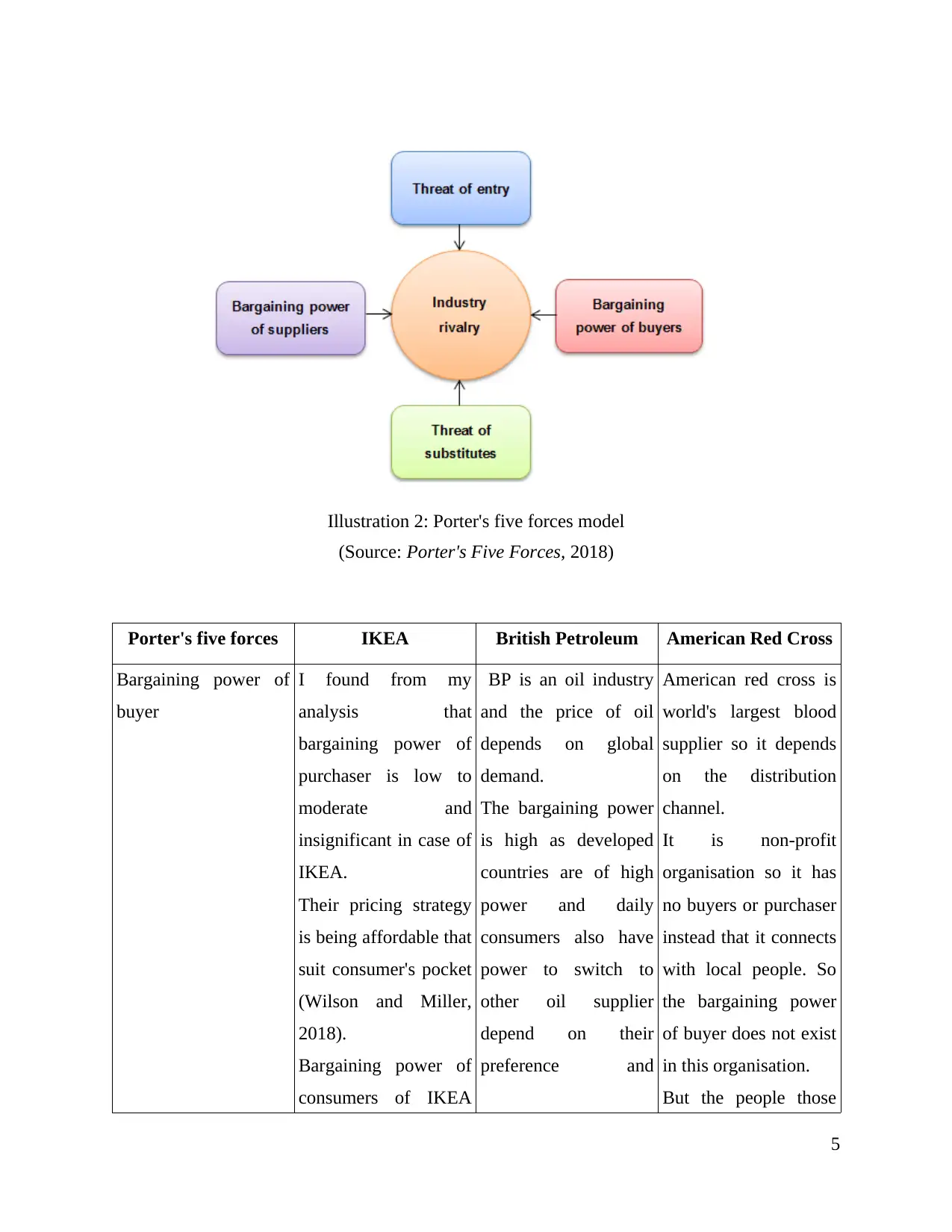
Porter's five forces IKEA British Petroleum American Red Cross
Bargaining power of
buyer
I found from my
analysis that
bargaining power of
purchaser is low to
moderate and
insignificant in case of
IKEA.
Their pricing strategy
is being affordable that
suit consumer's pocket
(Wilson and Miller,
2018).
Bargaining power of
consumers of IKEA
BP is an oil industry
and the price of oil
depends on global
demand.
The bargaining power
is high as developed
countries are of high
power and daily
consumers also have
power to switch to
other oil supplier
depend on their
preference and
American red cross is
world's largest blood
supplier so it depends
on the distribution
channel.
It is non-profit
organisation so it has
no buyers or purchaser
instead that it connects
with local people. So
the bargaining power
of buyer does not exist
in this organisation.
But the people those
5
Illustration 2: Porter's five forces model
(Source: Porter's Five Forces, 2018)
Bargaining power of
buyer
I found from my
analysis that
bargaining power of
purchaser is low to
moderate and
insignificant in case of
IKEA.
Their pricing strategy
is being affordable that
suit consumer's pocket
(Wilson and Miller,
2018).
Bargaining power of
consumers of IKEA
BP is an oil industry
and the price of oil
depends on global
demand.
The bargaining power
is high as developed
countries are of high
power and daily
consumers also have
power to switch to
other oil supplier
depend on their
preference and
American red cross is
world's largest blood
supplier so it depends
on the distribution
channel.
It is non-profit
organisation so it has
no buyers or purchaser
instead that it connects
with local people. So
the bargaining power
of buyer does not exist
in this organisation.
But the people those
5
Illustration 2: Porter's five forces model
(Source: Porter's Five Forces, 2018)
Paraphrase This Document
Need a fresh take? Get an instant paraphrase of this document with our AI Paraphraser
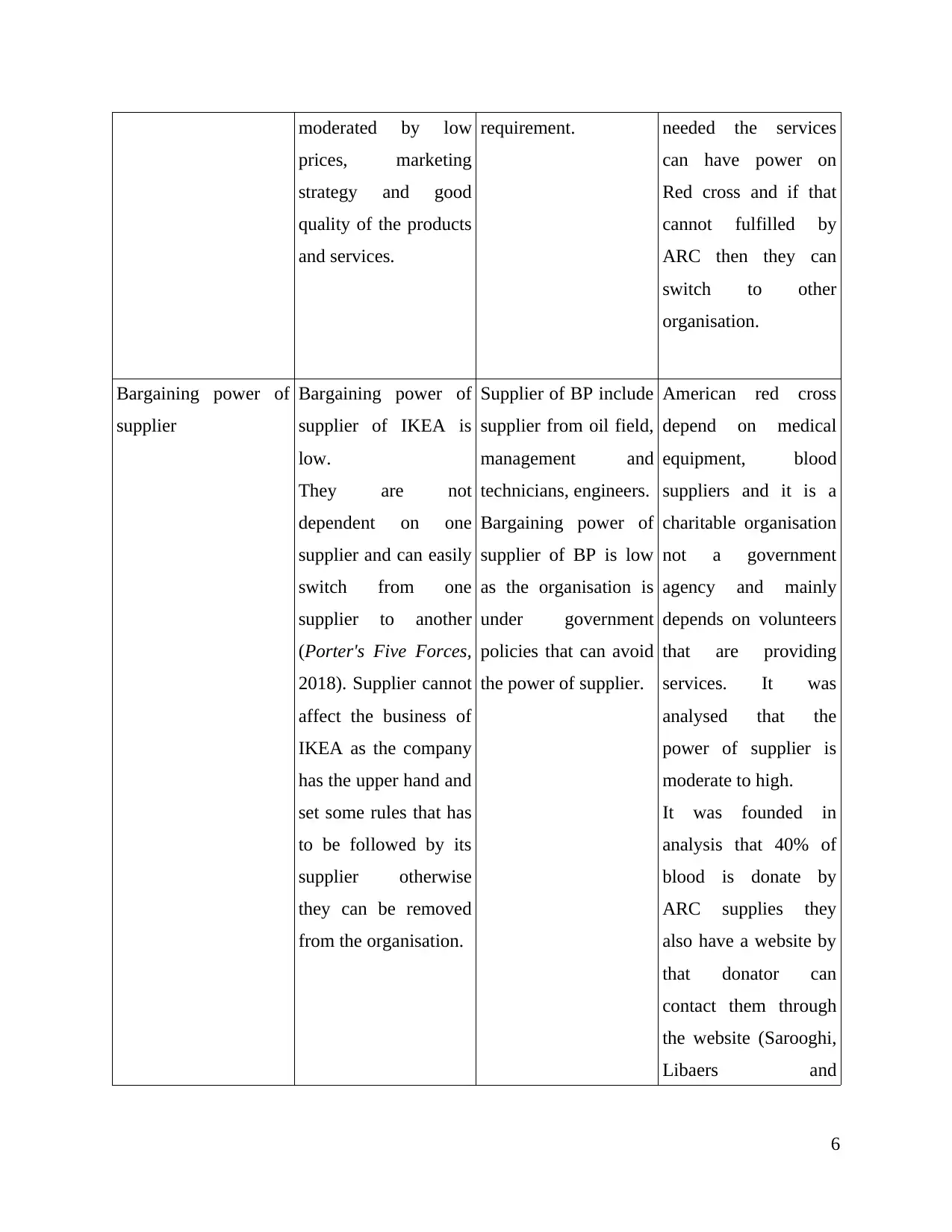
moderated by low
prices, marketing
strategy and good
quality of the products
and services.
requirement. needed the services
can have power on
Red cross and if that
cannot fulfilled by
ARC then they can
switch to other
organisation.
Bargaining power of
supplier
Bargaining power of
supplier of IKEA is
low.
They are not
dependent on one
supplier and can easily
switch from one
supplier to another
(Porter's Five Forces,
2018). Supplier cannot
affect the business of
IKEA as the company
has the upper hand and
set some rules that has
to be followed by its
supplier otherwise
they can be removed
from the organisation.
Supplier of BP include
supplier from oil field,
management and
technicians, engineers.
Bargaining power of
supplier of BP is low
as the organisation is
under government
policies that can avoid
the power of supplier.
American red cross
depend on medical
equipment, blood
suppliers and it is a
charitable organisation
not a government
agency and mainly
depends on volunteers
that are providing
services. It was
analysed that the
power of supplier is
moderate to high.
It was founded in
analysis that 40% of
blood is donate by
ARC supplies they
also have a website by
that donator can
contact them through
the website (Sarooghi,
Libaers and
6
prices, marketing
strategy and good
quality of the products
and services.
requirement. needed the services
can have power on
Red cross and if that
cannot fulfilled by
ARC then they can
switch to other
organisation.
Bargaining power of
supplier
Bargaining power of
supplier of IKEA is
low.
They are not
dependent on one
supplier and can easily
switch from one
supplier to another
(Porter's Five Forces,
2018). Supplier cannot
affect the business of
IKEA as the company
has the upper hand and
set some rules that has
to be followed by its
supplier otherwise
they can be removed
from the organisation.
Supplier of BP include
supplier from oil field,
management and
technicians, engineers.
Bargaining power of
supplier of BP is low
as the organisation is
under government
policies that can avoid
the power of supplier.
American red cross
depend on medical
equipment, blood
suppliers and it is a
charitable organisation
not a government
agency and mainly
depends on volunteers
that are providing
services. It was
analysed that the
power of supplier is
moderate to high.
It was founded in
analysis that 40% of
blood is donate by
ARC supplies they
also have a website by
that donator can
contact them through
the website (Sarooghi,
Libaers and
6
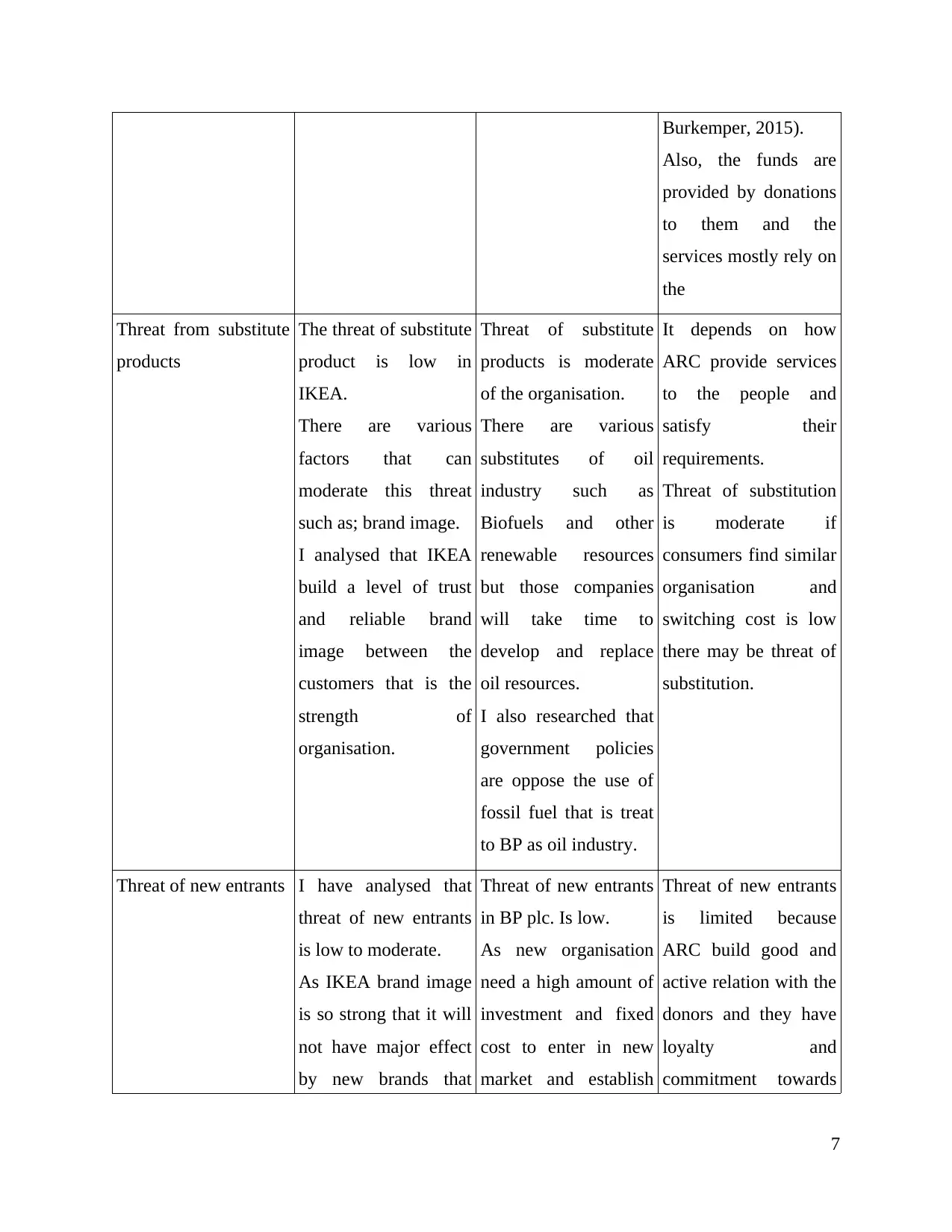
Burkemper, 2015).
Also, the funds are
provided by donations
to them and the
services mostly rely on
the
Threat from substitute
products
The threat of substitute
product is low in
IKEA.
There are various
factors that can
moderate this threat
such as; brand image.
I analysed that IKEA
build a level of trust
and reliable brand
image between the
customers that is the
strength of
organisation.
Threat of substitute
products is moderate
of the organisation.
There are various
substitutes of oil
industry such as
Biofuels and other
renewable resources
but those companies
will take time to
develop and replace
oil resources.
I also researched that
government policies
are oppose the use of
fossil fuel that is treat
to BP as oil industry.
It depends on how
ARC provide services
to the people and
satisfy their
requirements.
Threat of substitution
is moderate if
consumers find similar
organisation and
switching cost is low
there may be threat of
substitution.
Threat of new entrants I have analysed that
threat of new entrants
is low to moderate.
As IKEA brand image
is so strong that it will
not have major effect
by new brands that
Threat of new entrants
in BP plc. Is low.
As new organisation
need a high amount of
investment and fixed
cost to enter in new
market and establish
Threat of new entrants
is limited because
ARC build good and
active relation with the
donors and they have
loyalty and
commitment towards
7
Also, the funds are
provided by donations
to them and the
services mostly rely on
the
Threat from substitute
products
The threat of substitute
product is low in
IKEA.
There are various
factors that can
moderate this threat
such as; brand image.
I analysed that IKEA
build a level of trust
and reliable brand
image between the
customers that is the
strength of
organisation.
Threat of substitute
products is moderate
of the organisation.
There are various
substitutes of oil
industry such as
Biofuels and other
renewable resources
but those companies
will take time to
develop and replace
oil resources.
I also researched that
government policies
are oppose the use of
fossil fuel that is treat
to BP as oil industry.
It depends on how
ARC provide services
to the people and
satisfy their
requirements.
Threat of substitution
is moderate if
consumers find similar
organisation and
switching cost is low
there may be threat of
substitution.
Threat of new entrants I have analysed that
threat of new entrants
is low to moderate.
As IKEA brand image
is so strong that it will
not have major effect
by new brands that
Threat of new entrants
in BP plc. Is low.
As new organisation
need a high amount of
investment and fixed
cost to enter in new
market and establish
Threat of new entrants
is limited because
ARC build good and
active relation with the
donors and they have
loyalty and
commitment towards
7
⊘ This is a preview!⊘
Do you want full access?
Subscribe today to unlock all pages.

Trusted by 1+ million students worldwide
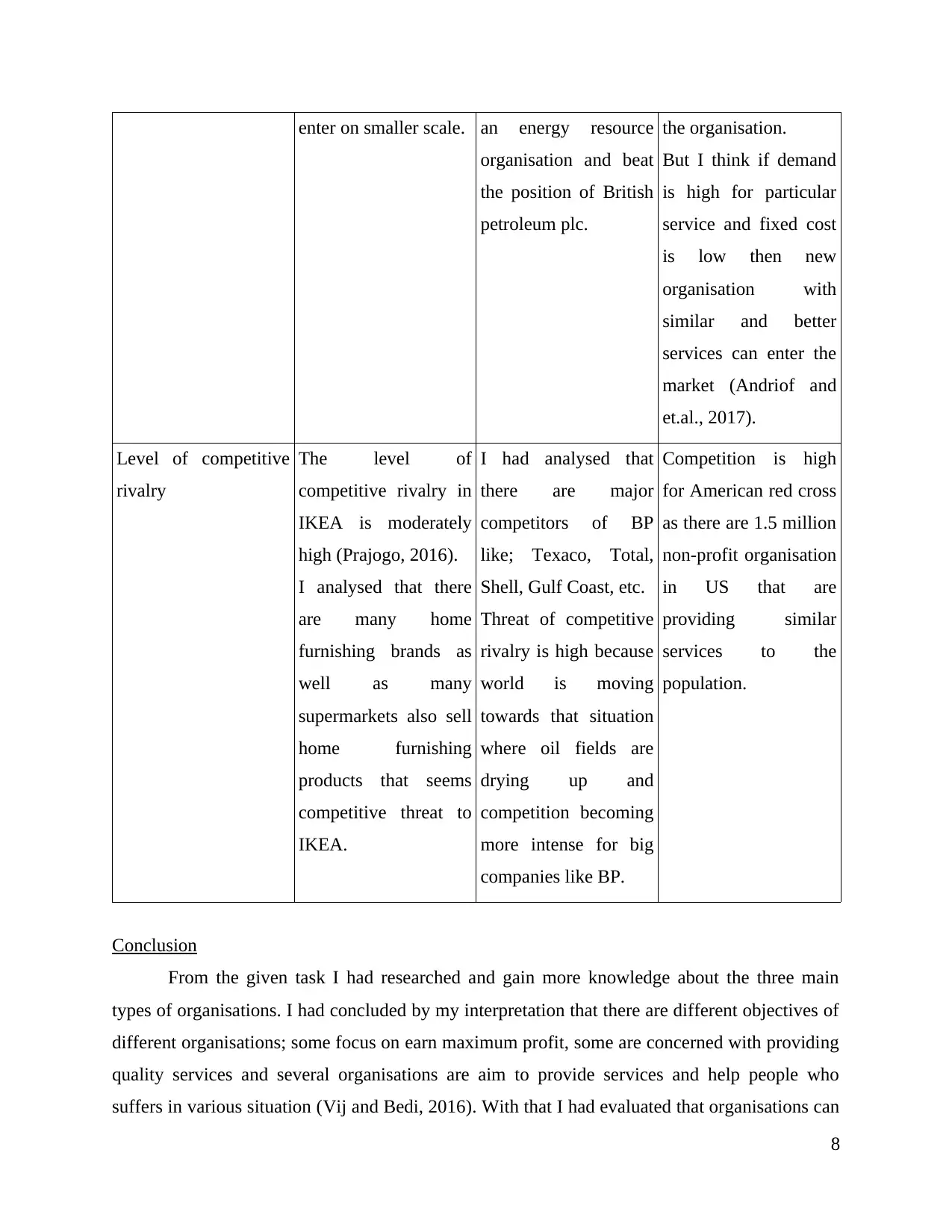
enter on smaller scale. an energy resource
organisation and beat
the position of British
petroleum plc.
the organisation.
But I think if demand
is high for particular
service and fixed cost
is low then new
organisation with
similar and better
services can enter the
market (Andriof and
et.al., 2017).
Level of competitive
rivalry
The level of
competitive rivalry in
IKEA is moderately
high (Prajogo, 2016).
I analysed that there
are many home
furnishing brands as
well as many
supermarkets also sell
home furnishing
products that seems
competitive threat to
IKEA.
I had analysed that
there are major
competitors of BP
like; Texaco, Total,
Shell, Gulf Coast, etc.
Threat of competitive
rivalry is high because
world is moving
towards that situation
where oil fields are
drying up and
competition becoming
more intense for big
companies like BP.
Competition is high
for American red cross
as there are 1.5 million
non-profit organisation
in US that are
providing similar
services to the
population.
Conclusion
From the given task I had researched and gain more knowledge about the three main
types of organisations. I had concluded by my interpretation that there are different objectives of
different organisations; some focus on earn maximum profit, some are concerned with providing
quality services and several organisations are aim to provide services and help people who
suffers in various situation (Vij and Bedi, 2016). With that I had evaluated that organisations can
8
organisation and beat
the position of British
petroleum plc.
the organisation.
But I think if demand
is high for particular
service and fixed cost
is low then new
organisation with
similar and better
services can enter the
market (Andriof and
et.al., 2017).
Level of competitive
rivalry
The level of
competitive rivalry in
IKEA is moderately
high (Prajogo, 2016).
I analysed that there
are many home
furnishing brands as
well as many
supermarkets also sell
home furnishing
products that seems
competitive threat to
IKEA.
I had analysed that
there are major
competitors of BP
like; Texaco, Total,
Shell, Gulf Coast, etc.
Threat of competitive
rivalry is high because
world is moving
towards that situation
where oil fields are
drying up and
competition becoming
more intense for big
companies like BP.
Competition is high
for American red cross
as there are 1.5 million
non-profit organisation
in US that are
providing similar
services to the
population.
Conclusion
From the given task I had researched and gain more knowledge about the three main
types of organisations. I had concluded by my interpretation that there are different objectives of
different organisations; some focus on earn maximum profit, some are concerned with providing
quality services and several organisations are aim to provide services and help people who
suffers in various situation (Vij and Bedi, 2016). With that I had evaluated that organisations can
8
Paraphrase This Document
Need a fresh take? Get an instant paraphrase of this document with our AI Paraphraser
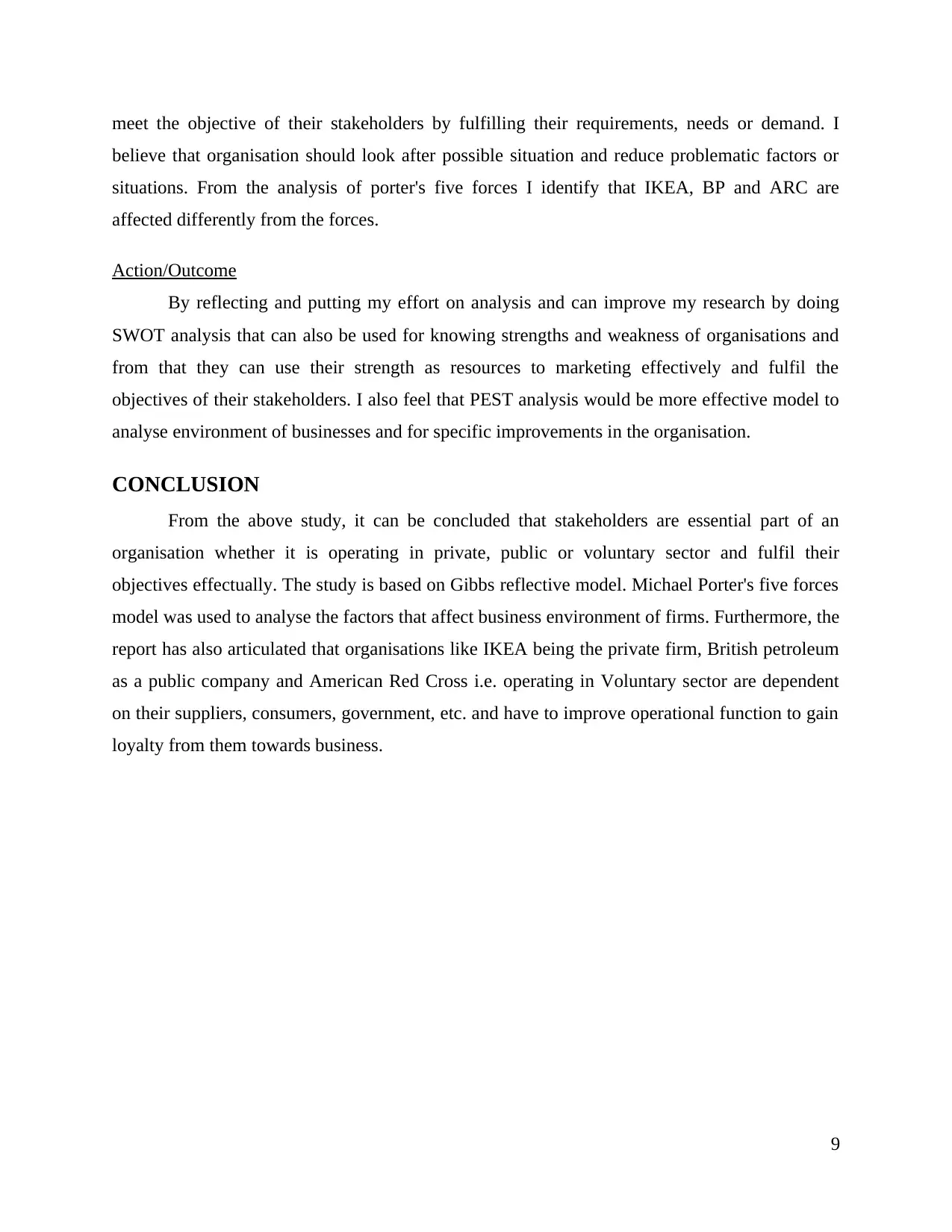
meet the objective of their stakeholders by fulfilling their requirements, needs or demand. I
believe that organisation should look after possible situation and reduce problematic factors or
situations. From the analysis of porter's five forces I identify that IKEA, BP and ARC are
affected differently from the forces.
Action/Outcome
By reflecting and putting my effort on analysis and can improve my research by doing
SWOT analysis that can also be used for knowing strengths and weakness of organisations and
from that they can use their strength as resources to marketing effectively and fulfil the
objectives of their stakeholders. I also feel that PEST analysis would be more effective model to
analyse environment of businesses and for specific improvements in the organisation.
CONCLUSION
From the above study, it can be concluded that stakeholders are essential part of an
organisation whether it is operating in private, public or voluntary sector and fulfil their
objectives effectually. The study is based on Gibbs reflective model. Michael Porter's five forces
model was used to analyse the factors that affect business environment of firms. Furthermore, the
report has also articulated that organisations like IKEA being the private firm, British petroleum
as a public company and American Red Cross i.e. operating in Voluntary sector are dependent
on their suppliers, consumers, government, etc. and have to improve operational function to gain
loyalty from them towards business.
9
believe that organisation should look after possible situation and reduce problematic factors or
situations. From the analysis of porter's five forces I identify that IKEA, BP and ARC are
affected differently from the forces.
Action/Outcome
By reflecting and putting my effort on analysis and can improve my research by doing
SWOT analysis that can also be used for knowing strengths and weakness of organisations and
from that they can use their strength as resources to marketing effectively and fulfil the
objectives of their stakeholders. I also feel that PEST analysis would be more effective model to
analyse environment of businesses and for specific improvements in the organisation.
CONCLUSION
From the above study, it can be concluded that stakeholders are essential part of an
organisation whether it is operating in private, public or voluntary sector and fulfil their
objectives effectually. The study is based on Gibbs reflective model. Michael Porter's five forces
model was used to analyse the factors that affect business environment of firms. Furthermore, the
report has also articulated that organisations like IKEA being the private firm, British petroleum
as a public company and American Red Cross i.e. operating in Voluntary sector are dependent
on their suppliers, consumers, government, etc. and have to improve operational function to gain
loyalty from them towards business.
9
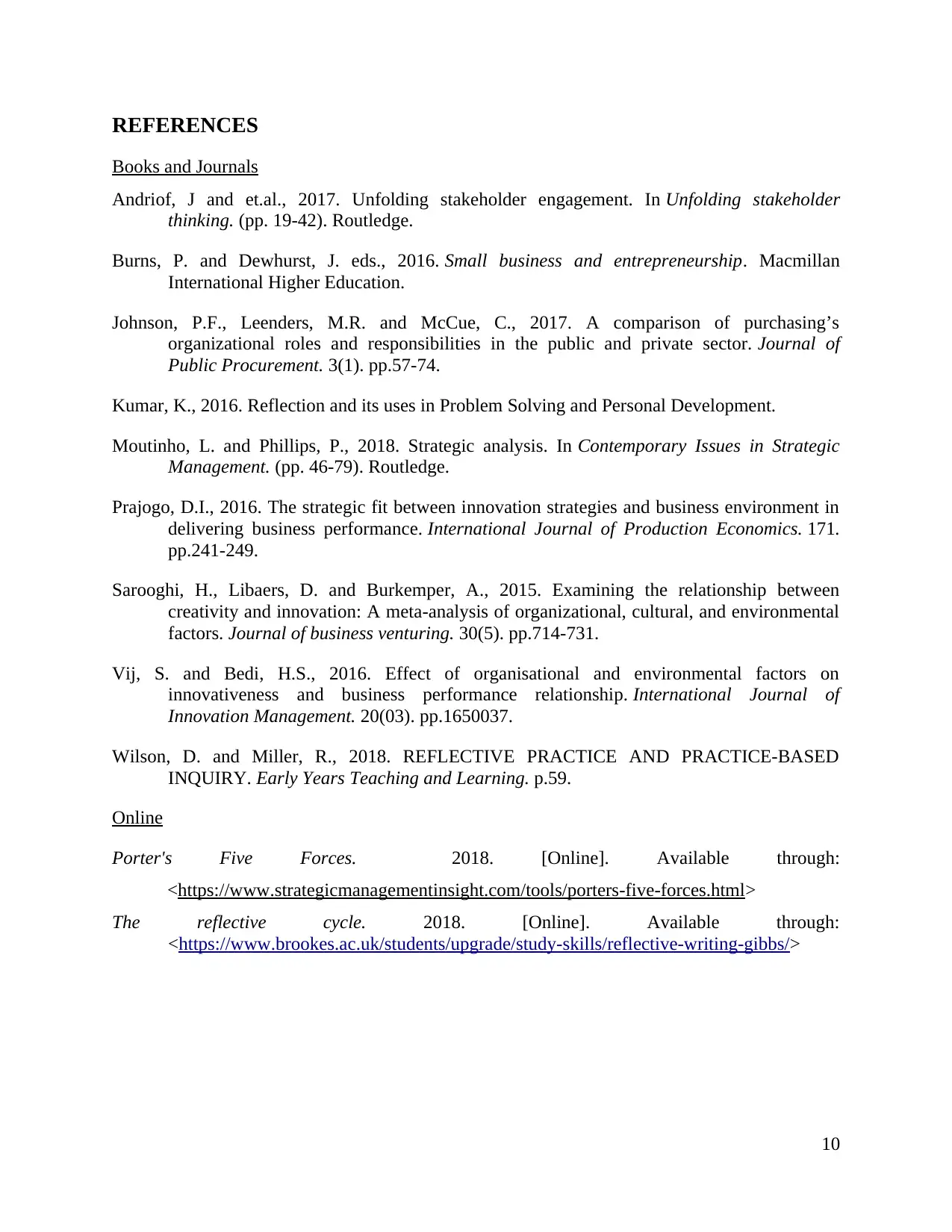
REFERENCES
Books and Journals
Andriof, J and et.al., 2017. Unfolding stakeholder engagement. In Unfolding stakeholder
thinking. (pp. 19-42). Routledge.
Burns, P. and Dewhurst, J. eds., 2016. Small business and entrepreneurship. Macmillan
International Higher Education.
Johnson, P.F., Leenders, M.R. and McCue, C., 2017. A comparison of purchasing’s
organizational roles and responsibilities in the public and private sector. Journal of
Public Procurement. 3(1). pp.57-74.
Kumar, K., 2016. Reflection and its uses in Problem Solving and Personal Development.
Moutinho, L. and Phillips, P., 2018. Strategic analysis. In Contemporary Issues in Strategic
Management. (pp. 46-79). Routledge.
Prajogo, D.I., 2016. The strategic fit between innovation strategies and business environment in
delivering business performance. International Journal of Production Economics. 171.
pp.241-249.
Sarooghi, H., Libaers, D. and Burkemper, A., 2015. Examining the relationship between
creativity and innovation: A meta-analysis of organizational, cultural, and environmental
factors. Journal of business venturing. 30(5). pp.714-731.
Vij, S. and Bedi, H.S., 2016. Effect of organisational and environmental factors on
innovativeness and business performance relationship. International Journal of
Innovation Management. 20(03). pp.1650037.
Wilson, D. and Miller, R., 2018. REFLECTIVE PRACTICE AND PRACTICE-BASED
INQUIRY. Early Years Teaching and Learning. p.59.
Online
Porter's Five Forces. 2018. [Online]. Available through:
<https://www.strategicmanagementinsight.com/tools/porters-five-forces.html>
The reflective cycle. 2018. [Online]. Available through:
<https://www.brookes.ac.uk/students/upgrade/study-skills/reflective-writing-gibbs/>
10
Books and Journals
Andriof, J and et.al., 2017. Unfolding stakeholder engagement. In Unfolding stakeholder
thinking. (pp. 19-42). Routledge.
Burns, P. and Dewhurst, J. eds., 2016. Small business and entrepreneurship. Macmillan
International Higher Education.
Johnson, P.F., Leenders, M.R. and McCue, C., 2017. A comparison of purchasing’s
organizational roles and responsibilities in the public and private sector. Journal of
Public Procurement. 3(1). pp.57-74.
Kumar, K., 2016. Reflection and its uses in Problem Solving and Personal Development.
Moutinho, L. and Phillips, P., 2018. Strategic analysis. In Contemporary Issues in Strategic
Management. (pp. 46-79). Routledge.
Prajogo, D.I., 2016. The strategic fit between innovation strategies and business environment in
delivering business performance. International Journal of Production Economics. 171.
pp.241-249.
Sarooghi, H., Libaers, D. and Burkemper, A., 2015. Examining the relationship between
creativity and innovation: A meta-analysis of organizational, cultural, and environmental
factors. Journal of business venturing. 30(5). pp.714-731.
Vij, S. and Bedi, H.S., 2016. Effect of organisational and environmental factors on
innovativeness and business performance relationship. International Journal of
Innovation Management. 20(03). pp.1650037.
Wilson, D. and Miller, R., 2018. REFLECTIVE PRACTICE AND PRACTICE-BASED
INQUIRY. Early Years Teaching and Learning. p.59.
Online
Porter's Five Forces. 2018. [Online]. Available through:
<https://www.strategicmanagementinsight.com/tools/porters-five-forces.html>
The reflective cycle. 2018. [Online]. Available through:
<https://www.brookes.ac.uk/students/upgrade/study-skills/reflective-writing-gibbs/>
10
⊘ This is a preview!⊘
Do you want full access?
Subscribe today to unlock all pages.

Trusted by 1+ million students worldwide
1 out of 12
Related Documents
Your All-in-One AI-Powered Toolkit for Academic Success.
+13062052269
info@desklib.com
Available 24*7 on WhatsApp / Email
![[object Object]](/_next/static/media/star-bottom.7253800d.svg)
Unlock your academic potential
Copyright © 2020–2025 A2Z Services. All Rights Reserved. Developed and managed by ZUCOL.




